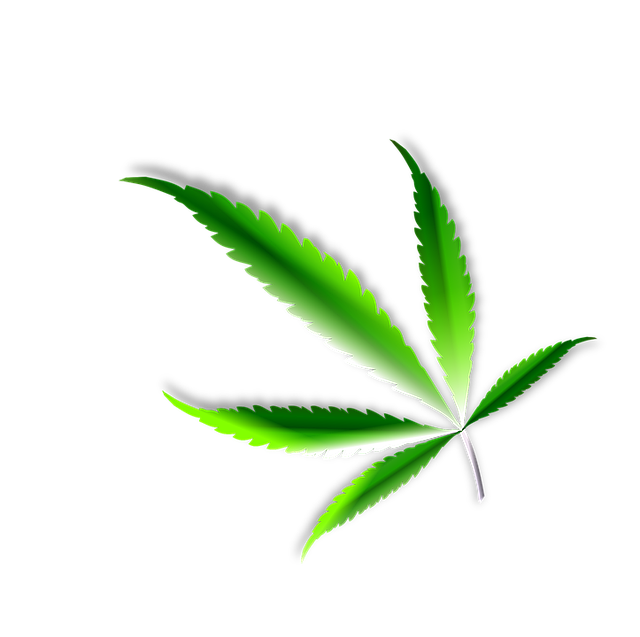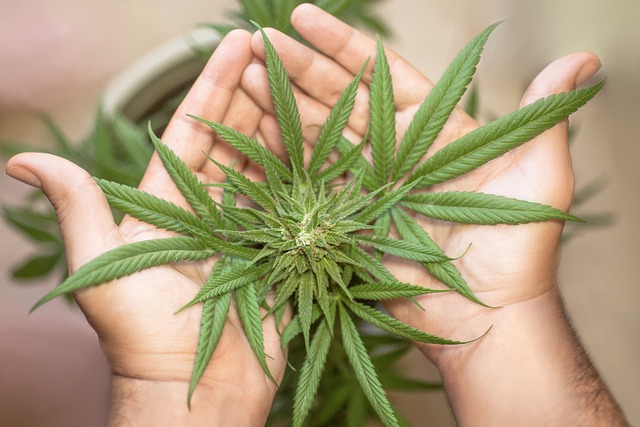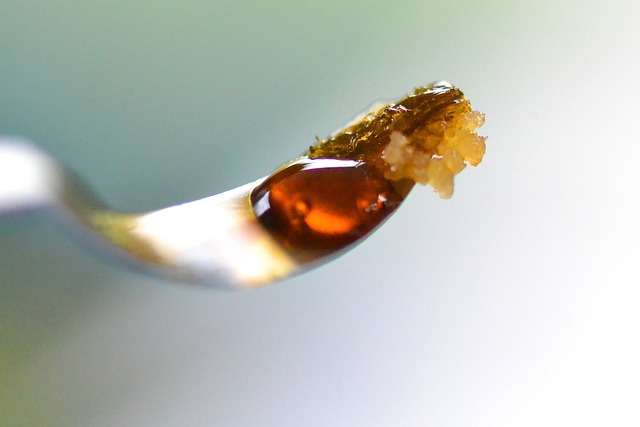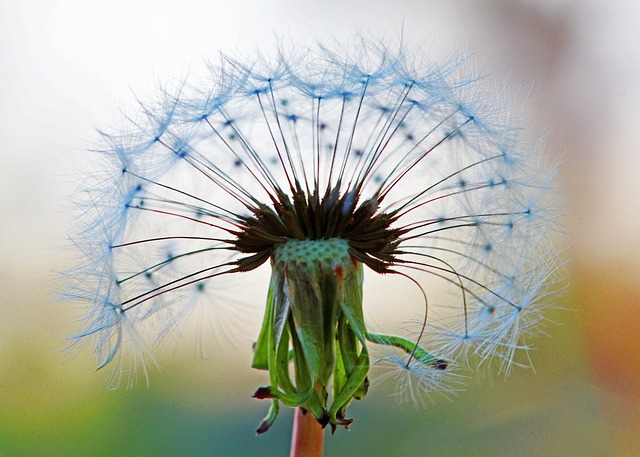
THCA flower lab reports are essential for understanding the potency, composition, and quality of cannabis products derived from the Cannabis sativa plant. These detailed analyses measure the levels of non-psychoactive THCA, alongside other cannabinoids like CBD and CBN, as well as the terpene profile that influences aroma and effects. The reports ensure product safety and consistency by confirming purity and potency through scientific validation using techniques like Gas Chromatography-Mass Spectrometry (GC-MS). They guide growers in optimizing cultivation conditions to maintain high THCA content, from selecting the right strain to managing environmental factors during growth. Harvesting at peak maturity, when trichomes appear milky, and proper post-harvest care, including curing under specific conditions, are critical for preserving the integrity of THCA. Lab reports also provide guidance on decarboxylation processes to convert THCA into its active form, THC, which is necessary for activating the desired effects. These reports support responsible product development, standardize dosages, and ensure legal compliance by providing precise data on cannabinoid and terpene levels. They educate consumers on how to use products effectively and safely, fostering trust in the market for THCA flower-based goods. In essence, THCA flower lab reports are a cornerstone of the cannabis industry, enhancing product safety, user satisfaction, and informed decision-making.
Explore the intricacies of THCA flowers, a botanical marvel with promising therapeutic potential. This article delves into the science and cultivation of these cannabinoid-rich blooms through comprehensive THCA flower lab reports. Discover tips for optimizing growth to produce high-quality flowers, learn about the post-harvest care required to maintain their potency, and understand the decarboxylation process that converts THCA into the more well-known psychoactive compound, THC. Additionally, gain insights on how these lab reports can shape product development and informed consumption in the cannabis industry. Embark on this educational journey to uncover the true potential of THCA flowers.
- Understanding THCA Flower: A Botanical Overview
- The Science Behind THCA Flower Lab Reports: What They Reveal
- Cultivating Excellence: Tips for Growing High-Quality THCA Flowers
- Harvesting and Post-Harvest Care for Optimal THCA Potency
- Decarboxylation Processes: Activating THCA into THC for Effective Use
- Utilizing THCA Flower Lab Reports in Product Development and Consumption
Understanding THCA Flower: A Botanical Overview

Understanding THCA flower begins with a comprehensive look at its botanical origins and chemical composition. Cannabis sativa, the plant from which THCA flower originates, contains over a hundred cannabinoids, with Tetrahydrocannabinolic Acid (THCA) being one of the most prominent. THCA is non-psychoactive but decarboxylates into THC upon heating or exposure to light, leading to the psychoactive effects commonly associated with cannabis. Lab reports are pivotal in confirming the presence and concentration of THCA within the flower, ensuring consumers and researchers have accurate data for safe and informed use. These reports detail the plant’s terpene profile, which influences both its aromatic qualities and potential therapeutic benefits. The entourage effect, a concept highlighting the synergistic interaction between cannabinoids and terpenes, is particularly relevant when assessing THCA flower’s efficacy. Lab-verified analyses of THCA flower provide users with reliable information on its cannabinoid content, allowing for precise dosing and application in various wellness routines. The botanical examination of the THCA flower also encompasses its trichome density, which is indicative of its potency and effectiveness. This attention to detail through laboratory testing underscores the importance of scientific rigor in the cannabis industry, ensuring that consumers receive a product that meets their needs and expectations.
The Science Behind THCA Flower Lab Reports: What They Reveal

Laboratory reports on THCA flower, which stands for tetrahydrocannabinolic acid, offer a comprehensive analysis of the compound’s potency and purity. These reports are instrumental in understanding the precise chemical makeup of THCA flowers, which is crucial for consumers and producers alike. Through advanced chromatographic techniques such as Gas Chromatography-Mass Spectrometry (GC-MS), these lab reports provide detailed information on the cannabinoid profile of the flowers. They identify and quantify THCA alongside other cannabinoids like CBD and CBN, as well as terpenes that contribute to the unique effects and flavors associated with cannabis strains.
The data from THCA flower lab reports are vital for researchers and manufacturers in the cannabis industry. These findings enable them to ensure product consistency, safety, and efficacy. The potency levels reported can guide consumers on dosage and expected outcomes based on individual strain characteristics. Additionally, these reports often include a terpene profile breakdown, which is significant as terpenes play a key role in the entourage effect, influencing the therapeutic properties of the cannabis plant. Understanding the composition from lab reports helps stakeholders make informed decisions and enhances the overall quality control process within the industry.
Cultivating Excellence: Tips for Growing High-Quality THCA Flowers

Cultivating high-quality THCA flowers requires a meticulous approach and an understanding of the factors that influence their potency and yield. Begin with selecting a reputable strain known for its superior THCA content and lab reports that validate its quality. These reports should confirm the presence and percentage of THCA, ensuring that your cultivation efforts are focused on a product with the desired effects. Optimal growing conditions are paramount; provide ample sunlight, whether natural or artificial LED lighting that mimics the sun’s spectrum, to encourage robust vegetative growth. Monitor the pH levels and nutrient balance in your soil or soilless medium to maintain an environment conducive to THCA flourishing. Regularly test your plants with high-precision equipment to track their THCA levels throughout different stages of growth. Proper air circulation and humidity control within a controlled environment can protect your plants from unwanted pathogens and pests, further ensuring the purity and quality of your THCA flowers. As they approach maturity, adjust environmental conditions to promote the conversion of THC to THCA, as this cannabinoid precursor offers distinct therapeutic benefits. With careful attention to detail at every stage, from seed to harvest, you can cultivate THCA flowers that meet the highest standards, with lab reports to back their quality and potency.
Harvesting and Post-Harvest Care for Optimal THCA Potency

Harvesting THCA flowers at the peak of their maturity is pivotal for preserving their potency, as indicated by thorough lab reports detailing the cannabinoid’s concentration. Timing your harvest correctly involves monitoring trichome development under controlled environmental conditions, ensuring that the THCA crystals are milky and fully formed. This stage signifies a high concentration of THCA, which is the raw form of THC before decarboxylation upon heating. It’s imperative to handle the plants gently during the harvest process to avoid bruising or damage that could lead to degradation of THCA. After harvesting, proper post-harvest care is essential to maintain the integrity and potency of the THCA. This includes curing the flowers in a controlled humidity and temperature environment, which typically ranges between 59°F to 72°F (15°C to 22°C) with 40-60% humidity. The curing process can take several weeks, depending on the strain and environmental conditions. Regular inspection and adjustment of these parameters will help prevent mold growth and maximize the preservation of THCA. Additionally, proper airflow and ventilation are crucial to ensure even drying and to prevent the accumulation of any moisture that could lead to unwanted microbial growth or degradation of the precious cannabinoid.
Post-harvest lab reports play a significant role in verifying the success of these practices. These reports provide analytical data on the THCA content, ensuring that the flowers maintain their desired potency levels. The lab reports serve as a reliable benchmark for the quality control process, enabling growers to refine their methods and techniques for future harvests. Adhering to best practices in both harvesting and post-harvest care not only ensures high-quality THCA flowers but also lays the groundwork for achieving consistent lab report results that reflect the true potency of the product. This commitment to quality is what separates exceptional THCA flower products from the rest, ensuring consumers receive a product that meets their expectations for efficacy and purity.
Decarboxylation Processes: Activating THCA into THC for Effective Use

Laboratory-verified THCA flower lab reports provide a scientific basis for understanding the decarboxylation process that is essential for activating tetrahydrocannabinolic acid (THCA) into its psychoactive form, THC. Decarboxylation is a chemical reaction where THCA loses a carboxyl group under heat, light, or time. This process transforms the non-psychoactive THCA found in raw cannabis flowers into the active THC that produces the desired effects.
To effectively harness the therapeutic and psychoactive properties of THCA-rich flowers, proper decarboxylation is crucial. This can be achieved through various methods, with heat being the most common and efficient way to activate THC. The process typically involves heating the cannabis flowers at a specific temperature for a determined duration, which studies detailed in THCA flower lab reports have shown to optimize the conversion rate of THCA to THC. It is important for consumers and researchers alike to follow guidelines and employ precise control over the decarboxylation conditions to ensure the desired outcome. By doing so, users can fully utilize the potential benefits offered by cannabis products, as evidenced by empirical data from these lab reports.
Utilizing THCA Flower Lab Reports in Product Development and Consumption

Incorporating THCA flower lab reports is a pivotal step in the development and safe consumption of cannabis products. These detailed analyses provide critical insights into the cannabinoid profile, terpene content, and potency of the THCA flowers, which are essential for consumers seeking specific effects or therapeutic benefits. Manufacturers rely on these lab reports to standardize product dosages, ensure consistency across batches, and comply with legal regulations regarding cannabis potency and purity. The reports offer a comprehensive breakdown of the compounds present in the THCA flowers, which is vital for accurate product formulation and quality control processes. Furthermore, they guide consumers on how to use these products effectively, ensuring they receive the intended effects and are aware of any potential sensitivities or interactions with other substances. By integrating lab report data into product development, businesses can offer transparency and trust to their customers, fostering a reliable and responsible market for THCA flower-based products.
For consumers, understanding the content of these lab reports is equally important. They offer a clear picture of what to expect from the THCA flowers in terms of cannabinoid and terpene levels, which directly influences the flavor, aroma, and effects. This knowledge empowers users to make informed decisions about their consumption methods, whether they prefer smoking, vaporizing, or incorporating THCA flowers into edibles or topicals. Additionally, for those with specific health considerations, lab reports can highlight any potential allergens or contraindications, ensuring safe and enjoyable experiences. In essence, the utilization of THCA flower lab reports is a cornerstone of responsible product development and consumption in the cannabis industry, enhancing safety, efficacy, and user satisfaction.
In conclusion, the exploration of THCA flower lab reports has unveiled a wealth of knowledge about this botanical wonder. From the optimal conditions for cultivation to the precise methods for post-harvest care, understanding the intricacies of THCA flowers is crucial for those looking to harness their potential. The decarboxylation process, which transforms THCA into its psychoactive form, THC, is pivotal in maximizing efficacy and usability. These findings not only enrich our scientific understanding but also inform best practices in product development and consumption, ensuring a safer and more effective experience for users. As the field continues to evolve, leveraging comprehensive lab reports remains essential for the advancement of THCA flower applications.







